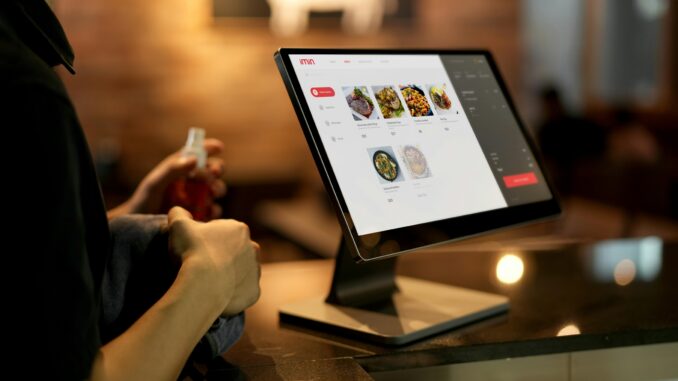
By Roman Davydov, Technology Observer at Itransition - 2.26.2024
Point-of-Sale (POS) software has already become critical for quick-service, full-service, and fast casual restaurants, helping process customer transactions and track sales data. According to Grand View Research, the restaurant POS terminal market segment alone reached $22.26 billion in 2023. Researchers expect the market to grow at a CAGR of 8.0% from 2023 to 2030.
To increase the value of POS solutions and streamline various tasks through seamless data exchange, restaurants can integrate POS with other software for online booking, menu management, or customer relationship management.
The following are five must-have POS system integrations for restaurant businesses and a look at their short- and long-term benefits.
1. Table booking software + POS
By integrating their POS systems with table reservation tools, restaurants can connect customers’ booking data with their spending data gathered at points of sale. This advantage allows restaurants to identify the most frequent customers and big spenders and take steps to increase their loyalty.
For instance, the client books a table via a booking solution integrated with POS. In this case, restaurant employees can review POS receipt data from the customer’s past reservations to determine the average number of guests in their party, their most purchased items, and their average spend per visit, including tips.
If the customer is considered highly valuable, employees can provide them with a more personalized service during the upcoming visit. For example, employees can suggest to the customer their favorite drink or dish or offer a discount, encouraging them to return to the restaurant in the future.
2. Online ordering + POS
Online ordering allows restaurants to receive delivery orders from customers from anywhere, providing a reliable source of income.
Thanks to the integration between online ordering software and POS systems, customers’ online orders can be automatically reflected in the POS system. This integration allows restaurants to avoid manual order input, which can not only improve data accuracy but also reduce employee workload, as they no longer have to transmit online orders into a restaurant’s POS system.
3. Menu management software + POS
Proper menu management is essential for creating a positive dining experience and driving sales. Restaurants need to have a deep understanding of their target audiences and conduct correct calculations to make their menus cost-effective and profitable.
Integrating POS with a menu management solution helps a restaurant create more engaging and better-performing menus based on valuable insights into sales for each menu position, sales of particular dishes during specific events, hours, or seasons, and the margin ratio for each menu position.
A POS solution integration can also help restaurant managers identify the best or worst-performing menu positions and tailor menu offerings accordingly. For instance, they can change the prices of certain dishes to increase their margins or move less popular yet profitable items higher on the menu, increasing their sales.
4. Customer loyalty apps + POS
Today, an increasing number of customers are willing to use loyalty programs. According to the 2023 Connected Dining report from PYMNTS, 49% of loyalty program users participate in these programs at quick-service restaurants and 34% at full-service restaurants.
From a restaurant business’s perspective, loyalty programs can help better retain customers and increase recurring revenue. Integrating customer loyalty software with PoS allows restaurants to further improve customer loyalty management and thus gain additional business benefits.
A POS system integrated with a loyalty solution can help restaurants not only register customers but also automatically update their profiles with earned rewards (points or discount coupons) each time a customer makes a purchase. Otherwise, employees would have to track rewards for each client manually, which is too time-consuming and ineffective.
Additionally, since a POS system processes sales and customer data, it can help a restaurant track the performance of its loyalty campaigns and make necessary improvements. For example, an employee can use the loyalty management-PoS integration to check the total and individual customers’ expenses and understand exactly how much they spend after registering in a loyalty program.
5. CRM + POS
This integration automates the sending of sales data from a POS to a CRM, helping restaurants better understand customers’ purchasing habits and preferences, including their favorite products, frequency of purchases, and other valuable information.
A restaurant can use this data to better tailor marketing activities, segment customers more accurately, and propose more personalized offers to their customers. As an option, a restaurant can even create separate landing pages for each target segment to increase customer engagement and sell more.
Common POS integration challenges
Although POS integration provides many business benefits, its implementation can be riddled with concerns that restaurants need to address throughout the project.
For example, if a restaurant decides to use a custom API solution, the company will need developers proficient in various protocols and programming languages, such as PHP, Java, or Python. If the restaurant’s IT team lacks the necessary qualifications, the company may have to hire the required specialists or outsource third-party talent.
In addition, restaurants need to test the performance and stability of the POS integration before the launch to ensure that it works correctly. Integration testing can become a project in itself, especially if there are multiple applications, environments, and databases involved and the testing scope is wide and complex.
Final thoughts
Restaurants continue to implement POS systems for automating and optimizing customer transactions, while the most efficiency-oriented ones also make sure to integrate their POS systems with other software in their IT ecosystems to streamline loyalty management, online ordering, booking, and other business aspects.
Although POS integration offers numerous advantages, it poses some challenges as well, with integration development and testing among them. Restaurant businesses can avoid these challenges by engaging third-party POS integration experts to develop and implement the integration solution, provide an testing strategy, and handle its maintenance.
 Roman Davydov is a Technology Observer at Itransition, a software development company that delivers corporate and consumer applications based on a profound understanding of technologies and the markets they operate in. With five years of experience in the IT industry, Roman follows and analyzes digital transformation trends to guide businesses in making informed software buying choices.
Roman Davydov is a Technology Observer at Itransition, a software development company that delivers corporate and consumer applications based on a profound understanding of technologies and the markets they operate in. With five years of experience in the IT industry, Roman follows and analyzes digital transformation trends to guide businesses in making informed software buying choices.
Are you an industry thought leader with a point of view on restaurant technology that you would like to share with our readers? If so, we invite you to review our editorial guidelines and submit your article for publishing consideration.

